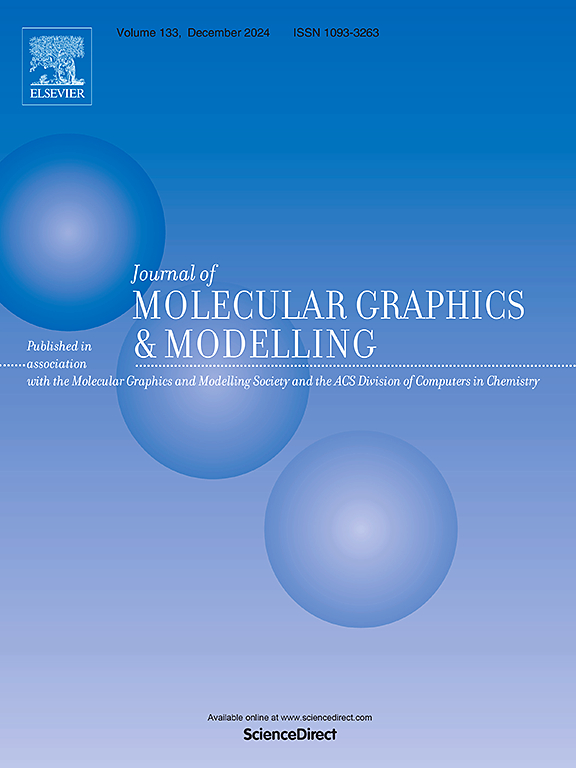Optimizing nonlinear optical and photovoltaic performance in butterfly-shaped carbazole vs. borole derivatives: An implicit and explicit solvents-driven approach
IF 2.7
4区 生物学
Q2 BIOCHEMICAL RESEARCH METHODS
引用次数: 0
Abstract
Nonlinear optical (NLO) materials play a crucial role in various hi-tech optoelectronic applications, driving the quest for novel molecular frameworks with superior properties. In this context, this study systematically explores derivatives of phenanthrene-carbazole and phenyleno-borole, aiming to finely tune their NLO properties by incorporating multiple push-pull groups at their molecular periphery. The integration of these push-pull groups with the central core significantly enhances intramolecular charge transfer (ICT) within the molecular structures, leading to improved optical and NLO properties. Our findings highlight compound 3-PB as a standout among the designated compounds, exhibiting exceptional linear optical properties with the maximum linear isotropic (αiso) value of 95.77 × 10−24 esu and a maximum anisotropic (αaniso) of 106.6 × 10−24 esu. Notably, it also shows an impressive average static third-order NLO polarizability <γ> amplitude of 574.1 × 10−36 esu. A comparative study reveals that the <γ> amplitude of 3-PB is ∼78 times greater than p-NA (7.29 × 10−36 esu) at the M06/6-311G∗∗ level of theory. TD-DFT computations further attribute the remarkable NLO response of 3-PB to its lower transition energy, setting it apart from the other designated molecular systems. Additionally, TD-DFT calculations explored structure-NLO property relations through FMOs, DOS, and MEP maps. A detailed comparison of NLO polarizabilities and electronic properties highlights the significance of carbazole and borole-based systems in achieving strong NLO responses. Notably, compound 3-PB exhibits enhanced NLO properties due to the presence of polyaromatic rings and a boron atom serving as an acceptor, along with dimethylamine (donor group) substitutions at the periphery of the molecule. Beyond exceptional NLO performance, our entitled systems also demonstrate favorable photovoltaic potential. Specifically, compound 3-PB exhibits the highest LHE value of 0.999. Additionally, open circuit voltage values range from 1.55 to 3.02 eV, while lower ΔGreg values suggest that these compounds are promising candidates for sensitizing DSSC performance.

优化蝴蝶形咔唑与硼ole衍生物的非线性光学和光伏性能:一种隐式和显式溶剂驱动方法。
非线性光学(NLO)材料在各种高科技光电应用中发挥着至关重要的作用,推动了对具有优越性能的新型分子框架的追求。在此背景下,本研究系统地探索了菲咔唑和苯波罗的衍生物,旨在通过在其分子边缘加入多个推拉基团来精细调节其NLO特性。这些推拉基团与中心核心的集成显著增强了分子结构内的分子内电荷转移(ICT),从而改善了光学和NLO性质。结果表明,化合物3-PB表现出优异的线性光学性质,最大线性各向同性(αiso)值为95.77 × 10-24 esu,最大各向异性(αaniso)值为106.6 × 10-24 esu。值得注意的是,它还显示出令人印象深刻的平均静态三阶NLO极化幅度为574.1 × 10-36 esu。对比研究表明,在理论的M06/6-311G∗∗水平上,3-PB的振幅比p-NA (7.29 × 10-36 esu)大~ 78倍。TD-DFT计算进一步将3-PB显著的NLO响应归因于其较低的跃迁能,使其与其他指定的分子体系区别开来。此外,TD-DFT计算通过FMOs、DOS和MEP映射探索了结构- nlo属性关系。对NLO极化率和电子性质的详细比较强调了咔唑和硼胺基体系在实现强NLO响应方面的重要性。值得注意的是,化合物3-PB由于存在多芳环和作为受体的硼原子,以及分子外围的二甲胺(供体基)取代,表现出增强的NLO性能。除了卓越的NLO性能外,我们的系统还显示出良好的光伏潜力。其中化合物3-PB的LHE值最高,为0.999。此外,开路电压值范围为1.55至3.02 eV,而较低的ΔGreg值表明这些化合物是增敏DSSC性能的有希望的候选者。
本文章由计算机程序翻译,如有差异,请以英文原文为准。
求助全文
约1分钟内获得全文
求助全文
来源期刊

Journal of molecular graphics & modelling
生物-计算机:跨学科应用
CiteScore
5.50
自引率
6.90%
发文量
216
审稿时长
35 days
期刊介绍:
The Journal of Molecular Graphics and Modelling is devoted to the publication of papers on the uses of computers in theoretical investigations of molecular structure, function, interaction, and design. The scope of the journal includes all aspects of molecular modeling and computational chemistry, including, for instance, the study of molecular shape and properties, molecular simulations, protein and polymer engineering, drug design, materials design, structure-activity and structure-property relationships, database mining, and compound library design.
As a primary research journal, JMGM seeks to bring new knowledge to the attention of our readers. As such, submissions to the journal need to not only report results, but must draw conclusions and explore implications of the work presented. Authors are strongly encouraged to bear this in mind when preparing manuscripts. Routine applications of standard modelling approaches, providing only very limited new scientific insight, will not meet our criteria for publication. Reproducibility of reported calculations is an important issue. Wherever possible, we urge authors to enhance their papers with Supplementary Data, for example, in QSAR studies machine-readable versions of molecular datasets or in the development of new force-field parameters versions of the topology and force field parameter files. Routine applications of existing methods that do not lead to genuinely new insight will not be considered.
 求助内容:
求助内容: 应助结果提醒方式:
应助结果提醒方式:


